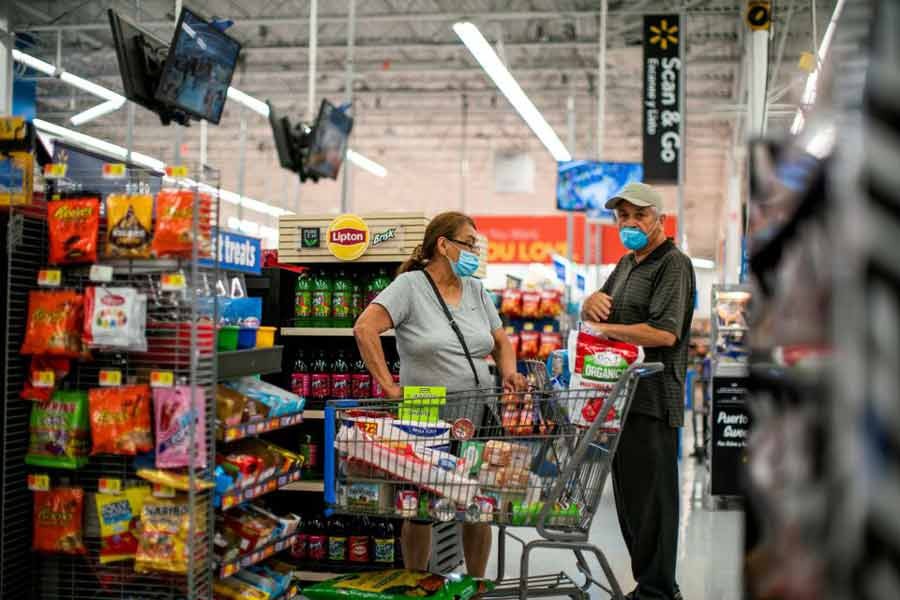US consumer prices accelerated in May as gasoline prices hit a record high and the cost of food soared, leading to the largest annual increase in nearly 40-1/2 years, suggesting that the Federal Reserve could continue with its 50 basis points interest rate hikes through September to combat inflation.
The faster-than-expected increase in inflation last month reported by the Labor Department on Friday also reflected a surge in rents, which increased by the most since 1990. The broadening and relentless price pressures are forcing Americans to change their spending habits, and heightened fears of either an outright recession or a period of very slow growth.
High inflation, a global phenomenon, also poses a political risk for President Joe Biden and his Democratic Party heading into the mid-term elections in November. A survey on Friday showed consumer sentiment plunged to a record low in early June.
"The Fed now recognises that it is way behind the curve on inflation and must act more decisively," said Sung Won Sohn, a finance and economics professor at Loyola Marymount University in Los Angeles. "Stagflation is the most likely scenario for the next couple of years, with the probability of a recession rising."
The consumer price index increased 1.0 per cent last month after gaining 0.3 per cent in April. Economists polled by Reuters had forecast the monthly CPI picking up 0.7 per cent.
Gasoline prices rebounded 4.1 per cent after falling 6.1 per cent in April. Prices at the pump shot up in May, averaging around $4.37 per gallon, according to data from AAA. They were flirting with $5 per gallon on Friday, indicating that the monthly CPI would remain elevated in June.
Prices of other energy goods also soared last month. Natural gas prices accelerated by 8.0 per cent, the most since October 2005. Electricity cost 1.3 per cent more.
Food prices jumped 1.2 per cent, with the cost of food consumed at home shooting up 1.4 per cent, marking the fifth straight increase of at least 1.0 per cent. Prices of dairy and related products notched their largest gain since July 2007. Food prices have soared following Russia's unprovoked war against Ukraine.
In the 12 months through May, the CPI increased by 8.6 per cent. That was the largest year-on-year increase since December 1981 and followed an 8.3 per cent advance in April. Economists had hoped that the annual CPI rate peaked in April.
Inflation by all measures has far exceeded the Fed's 2 per cent target and is eroding wage gains. Inflation-adjusted average hourly earnings fell 0.6 per cent last month.
The inflation report was published ahead of an anticipated second 50 basis points rate hike from the Fed next Wednesday. A handful of economists believe a 75 basis points increase is on the table. The US central bank is expected to raise its policy interest rate by an additional half a percentage point in July.
Economists had expected that the Fed would ease back to a quarter-point rise in September. But the broad-based increase in underlying inflation left many, including those at Goldman Sachs, expecting another 50 basis points hike in September. The Fed has hiked the overnight rate by 75 basis points since March.
Stocks on Wall Street tumbled. The dollar rose against a basket of currencies. US Treasury prices fell.
BROAD PRESSURES
Excluding the volatile food and energy components, the CPI climbed 0.6 per cent after advancing by the same margin in April.
Underlying inflation was fuelled by hot rents. Owners' equivalent rent of primary residence, which is what a homeowner would receive from renting a home, jumped 0.6 per cent. That was the largest increase since August 1990.
Rents, the biggest single expense for consumers, tend to be sticky and raise the prospect of a wage-price spiral. Record high house prices are forcing many people to remain renters.
"Consumers know these cost increases will not reverse, fuelling demands for higher wages to make ends meet," said Ron Temple, head of US equities at Lazard Asset Management in New York. "With labour markets the tightest in decades, employers have little choice other than to raise compensation, which in turn contributes to increasing services inflation. The Fed faces a mighty challenge breaking this potential wage-price spiral."
Airline fares increased 12.6 per cent, while medical care costs gained 0.4 per cent. Overall, core services prices rose 0.6 per cent. Core goods prices increased 0.7 per cent as used cars and truck prices rebounded after declining for three straight months. New motor vehicle prices advanced by 1.0 per cent.
Consumers also paid more for household furnishings and operations as well as recreation. Apparel prices rose 0.7 per cent, despite retailers holding excess merchandise.
There had been hoping that the shift in spending from goods to services would help to cool inflation. But the tight labour market is driving up wages, contributing to higher prices for services. China's zero COVID-19 policy, which dislocated supply chains, is also seen as keeping goods prices strong.
The so-called core CPI increased 6.0 per cent in the 12-months through May. That followed a 6.2 per cent rise in April. Inflation is seen gradually trending lower, though remaining above 6 per cent.
"The robust and broad-based CPI sequential momentum indicates the inflation slowdown through year-end will be anything but steep," said Greg Daco, chief economist at EY-Parthenon in New York.


